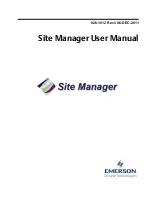
Chapter 14 Switch Configuration
NetAtlas Workgroup User’s Guide
148
14.4 Link Aggregation
Link aggregation (trunking) is the grouping of physical ports into one logical higher-capacity
link. You may want to trunk ports if for example, it is cheaper to use multiple lower-speed
links than to under-utilize a high-speed, but more costly, single-port link.
However, the more ports you aggregate then the fewer available ports you have. A link
aggregation group is one logical link containing multiple ports.
The first port must be physically connected when forming a trunk group.
Hello Time
This is the maximum time (in seconds) a device can wait without receiving a BPDU
before attempting to reconfigure. All device ports (except for designated ports) should
receive BPDUs at regular intervals. Any port that ages out STP information (provided
in the last BPDU) becomes the designated port for the attached LAN. If it is a root
port, a new root port is selected from among the device ports attached to the network.
The allowed range is 6 to 40 seconds (20 is the default).
Max Age
This is the time interval in seconds between BPDU (Bridge Protocol Data Units)
configuration message generations (by all devices in RSTP or the root device in STP).
The allowed range is 1 to 10 seconds (2 is the default).
Forwarding
Delay
This is the maximum time (in seconds) a device will wait before changing states. This
delay is required because every device must receive information about topology
changes before it starts to forward frames. In addition, each port needs time to listen
for conflicting information that would make it return to a blocking state; otherwise,
temporary data loops might result. The allowed range is 4 to 30 seconds (15 is the
default).
Rapid Spanning Tree Protocol
Active
Select this option to enable STP.
Bridge Priority Priority is used in determining the root device, root port and designated port. The
device with the highest priority (lowest numeric value) becomes the RSTP root device.
If all devices have the same priority, the device with the lowest MAC address will then
become the root device. The allowed range is 0 to 65535 (32768 is the default).
The lower the numeric value you assign, the higher the priority for this bridge.
Priority
determines the root bridge, which in turn determines
Hello Time
,
Max Age
and
Forward Delay
.
Max Age
This is the maximum time (in seconds) a device can wait without receiving a BPDU
before attempting to reconfigure. All device ports (except for designated ports) should
receive BPDUs at regular intervals. Any port that ages out STP information (provided
in the last BPDU) becomes the designated port for the attached LAN. If it is a root
port, a new root port is selected from among the device ports attached to the network.
The allowed range is 6 to 40 seconds (20 is the default).
Hello Time
This is the time interval in seconds between BPDU (Bridge Protocol Data Units)
configuration message generations (by all devices in RSTP or the root device in STP).
The allowed range is 1 to 10 seconds (2 is the default).
Forwarding
Delay
This is the maximum time (in seconds) a device will wait before changing states. This
delay is required because every device must receive information about topology
changes before it starts to forward frames. In addition, each port needs time to listen
for conflicting information that would make it return to a blocking state; otherwise,
temporary data loops might result. The allowed range is 4 to 30 seconds (15 is the
default).
Apply
Click
Apply
to save your changes back to the switch.
Table 66
Switch Configuration: Multiple STP Conf. (continued)
LABEL
DESCRIPTION
Summary of Contents for NetAtlas Workgroup
Page 2: ......
Page 6: ...Document Conventions NetAtlas Workgroup User s Guide 6 ...
Page 8: ...Contents Overview NetAtlas Workgroup User s Guide 8 ...
Page 16: ...Table of Contents NetAtlas Workgroup User s Guide 16 ...
Page 21: ...List of Figures NetAtlas Workgroup User s Guide 21 Figure 168 SNMPc Edit Button Bar Icons 230 ...
Page 22: ...List of Figures NetAtlas Workgroup User s Guide 22 ...
Page 27: ...27 PART I Introduction Introduction 29 Main EMS Screen 33 ...
Page 28: ...28 ...
Page 32: ...Chapter 1 Introduction NetAtlas Workgroup User s Guide 32 Figure 5 EMS Main Screen ...
Page 42: ...42 ...
Page 52: ...Chapter 3 Switch Manager NetAtlas Workgroup User s Guide 52 ...
Page 100: ...Chapter 8 Performance NetAtlas Workgroup User s Guide 100 ...
Page 118: ...Chapter 10 Maintenance NetAtlas Workgroup User s Guide 118 ...
Page 122: ...Chapter 11 Tools NetAtlas Workgroup User s Guide 122 ...
Page 124: ...124 ...
Page 190: ...Chapter 17 Multicast Configuration NetAtlas Workgroup User s Guide 190 ...
Page 224: ...Chapter 20 Troubleshooting NetAtlas Workgroup User s Guide 224 ...
Page 226: ...226 ...
Page 232: ...Appendix B Alarm Types and Causes NetAtlas Workgroup User s Guide 232 ...
















































